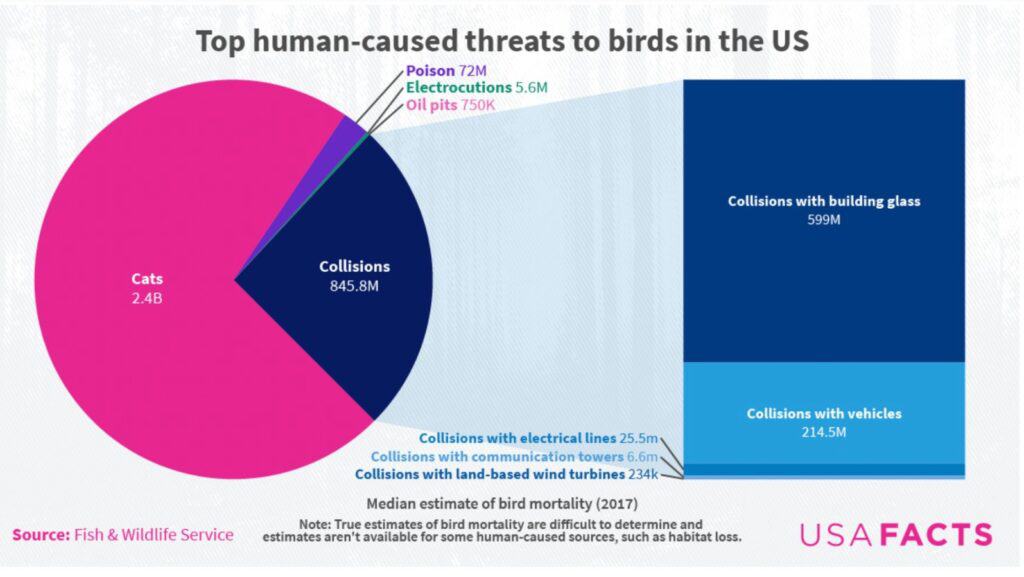People who oppose wind farms often claim wind turbines kill birds, and claim large numbers of birds are killed. They often refer to them as “bird choppers”. Claims of dangers to iconic or rare birds, especially raptors, have attracted a lot of attention. The Conversation published an article in 2017 that wind turbine farms are not the bird shredders many assume. and while it confirmed wind turbine blades do indeed kill birds and bats, their contribution to total bird deaths is extremely low. They reported on 3 studies. Wind turbine farms are an integral part of renewable Energy and offshore wind is part of this.
A recent 2 year comprehensive study in the North Sea off Aberdeen in Scotland had no deaths, and the birds adapted rapidly to the wind turbines (read below).
The impact of wind farms on bird populations has long been a contentious issue and efforts to mitigate it have given rise to a range of preventative technologies, including radar detection systems that monitor bird flight and adjust the operation of wind turbines to help avoid collisions. So what is the causes of bird deaths? Are there solutions to reduce bird deaths more?

Wind Turbines Kill Birds 2000 times less than Fossil Fuel Plants
The Conversation concluded that bird kills from wind turbines do occur, but much less than other causes of bird deaths. One measure is the rate per GWh of electricity generation.
Wind farms and nuclear power stations are responsible each for between 0.3 and 0.4 fatalities per gigawatt-hour (GWh) of electricity while fossil-fuelled power stations are responsible for about 5.2 fatalities per GWh. (15 times more)
Wind farms killed approximately seven thousand birds in the United States in 2006 but nuclear plants killed about 327,000 and fossil-fuelled power plants 14.5 million. (i.e. nuclear and fossil fuel plants killed 2118 birds more than wind farms)
Sovacool B. K., 2009. “Contextualizing avian mortality: A preliminary appraisal of bird and bat fatalities from wind, fossil-fuel, and nuclear electricity,” Energy Policy, Elsevier, vol. 37(6), pages 2241-2248, June.ol 2007 https://ideas.repec.org/a/eee/enepol/v37y2009i6p2241-2248.html
Black Blade on Wind Turbines Kills Birds 70% less.
In a study conducted over 10 years at a 68MW wind farm on the Norwegian archipelago of Smøla, the research team found an average of nearly 72% reduction in annual bird fatality rate at painted turbines, compared to non-painted control turbines. (From Renew Economy 2022).
Trials are underway in Australia – see https://reneweconomy.com.au/researchers-find-black-and-white-solution-to-wind-turbine-bird-deaths-96526/
Bird deaths caused by humans
| CAUSE OF BIRD DEATH | ALL BIRDS | CONTRIBUTION TO TOTAL HUMAN-RELATED BIRD DEATHS |
|---|---|---|
| Cats (feral) | 79,600,000 | 1 in 2.3 |
| Cats (domestic) | 54,880,000 | 1 in 3.4 |
| Power line collisions | 16,810,000 | 1 in 11.1 |
| Buildings (houses) | 16,390,000 | 1 in 11.4 |
| Road vehicle collisions | 9,814,000 | 1 in 19 |
| Harvest (game birds) | 2,817,000 | 1 in 66.2 |
| Buildings (low, mid & high rise) | 1,317,130 | 1 in 141.5 |
| Commercial forestry | 887,835 | 1 in 210 |
| Power electrocutions | 184,300 | 1 in 1,011.6 |
| Agriculture (haying & mowing) | 135,400 | 1 in 1,376.9 |
| Communication tower collisions | 101,500 | 1 in 1,836.7 |
| Wind energy collisions | 13,060 | 1 in 14,275 |
| All other | 3,479,328 | 1 in 53.6 |
| Total | 186,429,553 | 100 |
Quoted in https://theconversation.com/wind-farms-are-hardly-the-bird-slayers-theyre-made-out-to-be-heres-why-79567?
Carbon Brief Data
Carbon Brief infographic is below. Reference https://www.carbonbrief.org/bird-death-and-wind-turbines-a-look-at-the-evidence/

Bird Protection Societies Support Wind Power
Bird Protection Societies such as the UK Royal Society for Protection of Birds generally supports wind power – not because wind farms pose a lower risk to birds than other energy sources – but because in its view climate change poses the “single greatest long-term threat” to bird species. Climate change is predicted to harm bird populations by affecting breeding or migration patterns, or altering their habitats.
Latest Study Shows No Birds Killed
The latest research using radar and vision over 2 years ashowed no deaths. Vattenfall’s study looked at seabird behavior over a period of two years at the Aberdeen Offshore Wind Farm located in the North Sea on the east coast of Scotland. The company describes the study as most comprehensive and technologically advanced in the field to date, using radar and cameras to monitor how birds behaved.
What did the study find? Not a single collision between a bird and a blade was recorded. In fact, seabirds actually deliberately avoid wind turbine rotor blades offshore. (See https://gcaptain.com/new-study-finds-seabirds-birds-avoid-offshore-wind-turbines/)
Bird kill Avoidance Systems
Innovative work and technology as reported by the ABC titled wind farm trials camera detection to protect Tasmanian wedge-tailed eagles from blade strikes.

- Cameras mounted on towers detect eagles in flight and send messages to slow the turbine blades or turn them off
- Goldwind has paid $3 million for the US technology to trial at the Cattle Hill Wind Farm
- If an eagle is sighted, the technology will feather the turbines to create turbulence and hopefully the eagle will then veer away from the disturbance.
- But if the eagle continues its flight path, the technology then has the ability to turn off the turbines and track the bird until it is safe to restart the turbines.
Dr Erik Katovich – Wind Turbines are Friendlier than Oil and Gas Drilling
In an article in Jan 2024, the Economist reports on a recent study (paywalled). Dr Erik Katovich [an economist at the University of Geneva] combined bird population and species maps with the locations and construction dates of all wind turbines in the United States, with the exceptions of Alaska and Hawaii, between 2000 and 2020. He found that building turbines had no discernible effect on bird populations. That reassuring finding held even when he looked specifically at large birds like hawks, vultures and eagles that many people believe are particularly vulnerable to being struck.

But Dr. Katovich did not confine his analysis to wind power alone. He also examined oil-and-gas extraction. Like wind power, this has boomed in America over the past couple of decades, with the rise of shale gas produced by hydraulic fracturing, or fracking, of rocks. Production has risen from 37m cubic metres in 2007 to 740m cubic metres in 2020. Comparing bird populations to the locations of new gas wells revealed an average 15% drop in bird numbers when new wells were drilled, probably due to a combination of noise, air pollution and the disturbance of rivers and ponds that many birds rely upon. When drilling happens in places designated by the National Audubon Society as “important bird areas”, bird numbers instead dropped by 25%. Such places are typically migration hubs, feeding grounds or breeding locations.
Read More About Wind Turbines Kill Birds
- The avian and wildlife costs of fossil fuels and nuclear power, Benjamin K. Sovacool https://doi.org/10.1080/1943815X.2012.746993
- Weekly data: How many birds are really killed by wind turbines? Nick Ferris https://www.energymonitor.ai/tech/renewables/weekly-data-how-many-birds-are-really-killed-by-wind-turbines/










